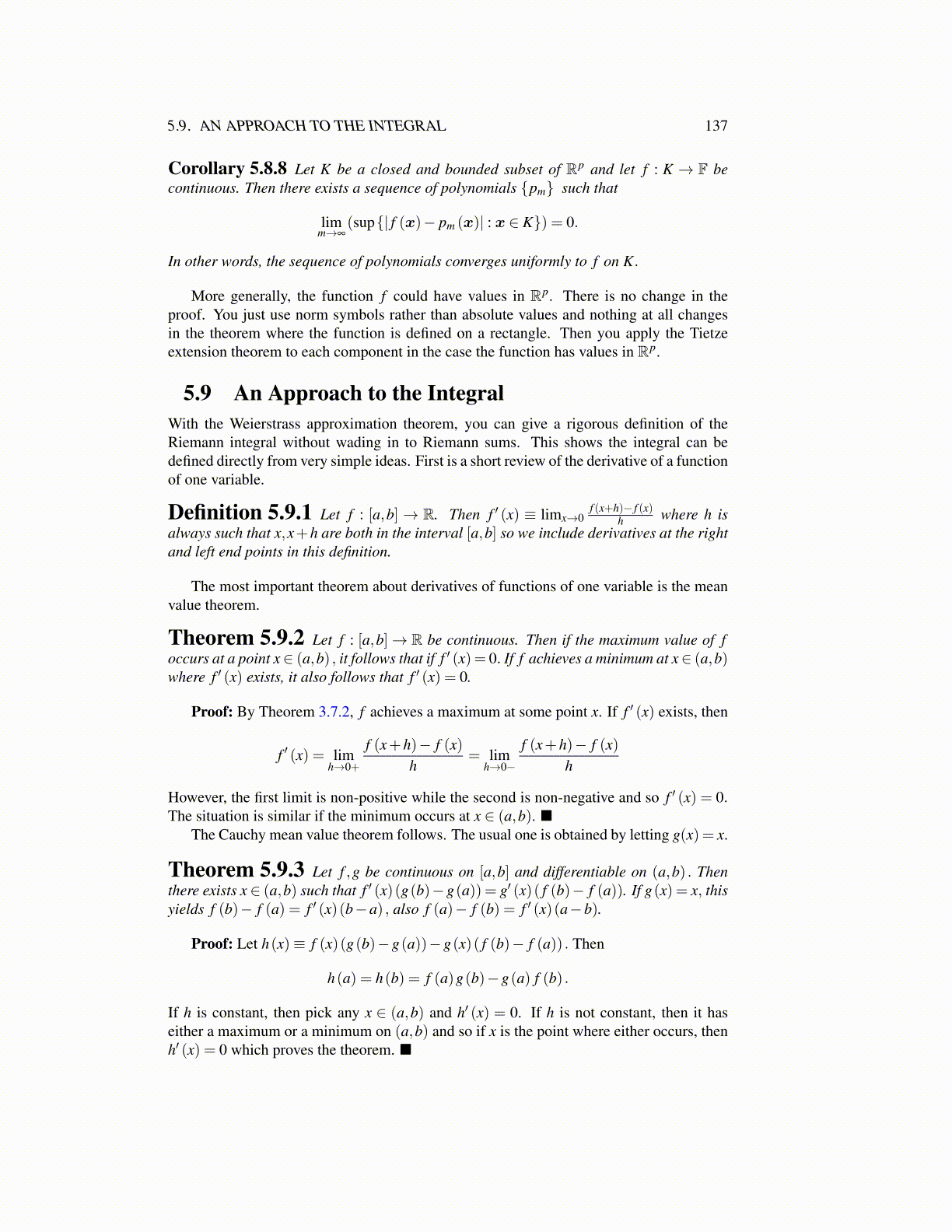
5.9. AN APPROACH TO THE INTEGRAL 137
Corollary 5.8.8 Let K be a closed and bounded subset of Rp and let f : K → F becontinuous. Then there exists a sequence of polynomials {pm} such that
limm→∞
(sup{| f (x)− pm (x)| : x ∈ K}) = 0.
In other words, the sequence of polynomials converges uniformly to f on K.
More generally, the function f could have values in Rp. There is no change in theproof. You just use norm symbols rather than absolute values and nothing at all changesin the theorem where the function is defined on a rectangle. Then you apply the Tietzeextension theorem to each component in the case the function has values in Rp.
5.9 An Approach to the IntegralWith the Weierstrass approximation theorem, you can give a rigorous definition of theRiemann integral without wading in to Riemann sums. This shows the integral can bedefined directly from very simple ideas. First is a short review of the derivative of a functionof one variable.
Definition 5.9.1 Let f : [a,b]→ R. Then f ′ (x) ≡ limx→0f (x+h)− f (x)
h where h isalways such that x,x+h are both in the interval [a,b] so we include derivatives at the rightand left end points in this definition.
The most important theorem about derivatives of functions of one variable is the meanvalue theorem.
Theorem 5.9.2 Let f : [a,b]→ R be continuous. Then if the maximum value of foccurs at a point x∈ (a,b) , it follows that if f ′ (x) = 0. If f achieves a minimum at x∈ (a,b)where f ′ (x) exists, it also follows that f ′ (x) = 0.
Proof: By Theorem 3.7.2, f achieves a maximum at some point x. If f ′ (x) exists, then
f ′ (x) = limh→0+
f (x+h)− f (x)h
= limh→0−
f (x+h)− f (x)h
However, the first limit is non-positive while the second is non-negative and so f ′ (x) = 0.The situation is similar if the minimum occurs at x ∈ (a,b). ■
The Cauchy mean value theorem follows. The usual one is obtained by letting g(x) = x.
Theorem 5.9.3 Let f ,g be continuous on [a,b] and differentiable on (a,b) . Thenthere exists x∈ (a,b) such that f ′ (x)(g(b)−g(a)) = g′ (x)( f (b)− f (a)). If g(x) = x, thisyields f (b)− f (a) = f ′ (x)(b−a) , also f (a)− f (b) = f ′ (x)(a−b).
Proof: Let h(x)≡ f (x)(g(b)−g(a))−g(x)( f (b)− f (a)) . Then
h(a) = h(b) = f (a)g(b)−g(a) f (b) .
If h is constant, then pick any x ∈ (a,b) and h′ (x) = 0. If h is not constant, then it haseither a maximum or a minimum on (a,b) and so if x is the point where either occurs, thenh′ (x) = 0 which proves the theorem. ■